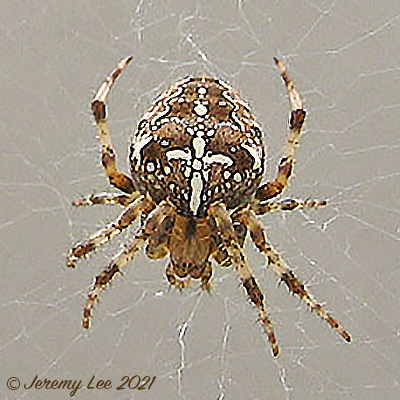
 |
|
Scientific Classifications explained » Amphibians » Ants » Aphids » Bees » Beetles » Birds » Bugs » Butterflies » Caterpillars » Damselflies » Dragonflies » Earwigs » Flies » Frog/Leafhoppers » Fungi » Galls » Grasshoppers » Harvestmen » Hoverflies » Lacewings » Ladybirds » Leaf Mines » Lichens » Mammals » Millipedes » Mosses » Moths » Sawflies » Slugs » Snails » Spiders » Trees & Shrubs » Wasps » Wild Flowers » Woodlice » Postboxes |
UK Nature > Spiders > Araneus diadematus

Scientific Name: Araneus diadematus Common Name: Garden Spider, Garden Cross Spider Araneus diadematus, more commonly known as the Garden Spider, or Garden Cross Spider, measures between 4 - 8mm in the male, the female being much bigger at 10 - 15mm. Both sexes of Araneus diadematus have a clear white cross of irregular-sized dots on the abdomen. Ground colour ranges from bright orange to black, but is usually some shade of brown. Spins a more or less vertical orb-web, usually well off the ground on bushes or fences, or between the branches of trees, and catches a wide range of flying insects. The spider usually hides close to the web, but sometimes sits motionless in the middle. Adult late summer and autumn, when the webs are most obvious. Overwinters in the egg stage, the eggs being enclosed in silken bags fixed in bark crevices or under window sills. Swarms of tiny yellow and brown spiderlings emerge from the bags in spring. Can be found in almost any well-vegetated habitat; very abundant in hedgerows and gardens. Very common throughout the UK. |
|

https://www.uknature.co.uk is a website dedicated to showing the immense diversity of UK nature and wildlife. Our vast range of habitats, from lowland arable to snow covered mountains, from storm-ravaged coastlines to peaceful inland freshwater lakes and rivers, from dry, sandy heaths to deciduous and coniferous forests, all these habitats contribute to the abundance of UK nature. We have wild birds in huge numbers either residing or visiting our shores (597 recorded species as at July 2013) and we must also not forget the humble back garden with its grass lawns, flower beds filled with nectar rich flowers, shrubs and trees, all designed to attract huge numbers of insects such as bees, moths, butterflies and hoverflies; and finally the small ponds which provide safe havens for frogs, toads, newts and even slow worms and grass snakes. www.uknature.co.uk is the showcase for my personal passion, photographing uknature in all its glory. I sincerely hope you all enjoy the fruits of my labours. This site and all images contained therein is © Jeremy Lee 2004 - 2025. All Rights Reserved. Site design by Jeremy Lee. Site development & IT Support by Stuart Lee. |